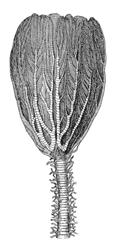
| Palaeos |  |
Echinodermata |
| Echinodermata | Echinodermata |
| Page Back | Unit Back | Unit Home | Unit References | Unit Dendrogram | Glossary | Taxon Index |
| Page Next | Unit Next | Metazoa | Metazoa References | Metazoa Dendrogram | Pieces | Time |

The echinoderms (or "spiny skins") are a diverse group of completely marine animals. They are known from the Cambrian to the Recent and are found in shallow marine waters as well as the deep abyssal plains.
They have a soft body encased in a hard rigid shell or exoskeleton (called a test) made of individual plates (or ossicles). made up of numerous thin plates. Many echinoderms have spines covering their test (e.g. the sea urchin). This group includes such familiar sea-shore creatures as starfish and sea urchins, as well as a number of less known types, and a whole range of paleozoic forms that are no longer around. there are some 6000 recent species, distributed among five classes. But these are only a small fraction of the number and diversity of types that lived in past ages, especially during the Paleozoic era when the group was at its height.
The most distinctive thing about echinoderm appearance is their pentameral - that is, a five fold - radial symmetry. In other words, their body is structured on a five-fold plan, with rays or arms in fives or multiples of five, as shown for example with the familiar starfish with its five arms.

Echinoderms also have a complex and unique water-vascular (or ambulacral) system; a hydrostatic skeleton of internal water-filled canals. This evolved originally as a food collecting and transporting device, but in some echinoderms like starfish and sea urchins is used primarily for movement by means of suckered "tube feet". It can also be used to grip objects and even in the case of starfish apply tremendous force to price open clams, upon which those animals feed.
Echinoderms larvae have bilateral symmetry (having a definite front and rear) while as adults this is lost. This shows that they evolved from normal ancestors and only secondarily reverted to radial symmetry.
Many early echinoderms were not pentameral at all, and had strange armoured shapes. Some types were able to crawl by nudging themselves along the sea floor with a sort of "tail".
Strange as it may seem, echinoderms are actually distant cousins of vertebrates. Both share a common type of embryonic development, and are grouped under the infrakingdom Deuterostomia.
|
|
Subphylum Blastozoa..........Class Parablastoidea (Ordovician, 3 genera) ..........Class Rhombifera = Cystoidea in part (Ordovician - Devonian, 60 genera) ..........Class Diploporita = Cystoidea in part (Ordovician - Devonian, 42 genera) ..........Class Blastoidea (Silurian - Permian, 95 genera) |
|
|
Subphylum Crinozoa..........Class Paracrinoidea (Ordovician - Silurian, 13-15 genera) |
 |
Subphylum Echinozoa..........Class Holothuroidea (Sea Cucumbers) (Ordovician - Recent, 200 genera) ..........Class Edrioasteroidea (Early Cambrian - Carboniferous, 35 genera) ..........Class Edrioblastoidea (Ordovician, 1 genus) ..........Class Helicoplacoidea (Cambrian, 3 genera) ..........Class Cyclocystoidea (Ordovician - Devonian, 8 genera) |
|
|
Subphylum Asterozoa (= Stelleroidea)..........Class Ophiuroidea - Brittle Stars -(Ordovician - Recent, 325 genera) |
| Links |
![]() Introduction
to the Echinodermata
Introduction
to the Echinodermata
| Page Back | Page Top | Unit Home | Page Next |
page uploaded 15 June 2002
(originally uploaded on Kheper Site 11 May 1999)
checked ATW021109
page text Creative Commons Attribution M. Alan Kazlev
this material may be freely used as long as attribution is given